Google Nexus 5 Review: A Fast, Affordable Phone With LTE For All
There's a new flagship smartphone in town. The LG-made Nexus 5 offers a fast Snapdragon platform, LTE for all markets, a 5” 1080p display, and Android 4.4 “KitKat”. Best of all, the 16 GB model sells for just $350 off-contract. Is it too good to be true?
Results: GPU Benchmarks
3DMark
Futuremark is a name synonymous with benchmarking GPUs, and 3DMark for mobile has quickly become a very popular tool for doing just that. 3DMark offers three main graphical benchmarks which simulate the demands of OpenGL ES 2.0 games using shaders, particles, and physics via the company’s in-house engine. The first test, Ice Storm, runs at a fixed 1280x720 resolution, while the second, Ice Storm Extreme, increases the resolution to 1920x1080. Finally, Ice Storm Unlimited renders the scene off-screen at 720p.
While it was just released in late May of this year, and is updated quite regularly, 3DMark is already being outpaced by more recent chipsets, with Nvidia’s Tegra 4 and Qualcomm’s Snapdragon 800/Adreno 330 both easily maxing out the Extreme (1080p) benchmark.
One more thing: although we have scores for HTC's One in this test, Futuremark delisted the device for deliberate application detection. In short, this is one test where cheating is confirmed. We are deliberately running an extensive suite of tests to help mitigate some of the complex mechanisms by which device vendors are optimizing, but in this case, the infraction is called out beforehand. The other devices check out in Futuremark's results list.
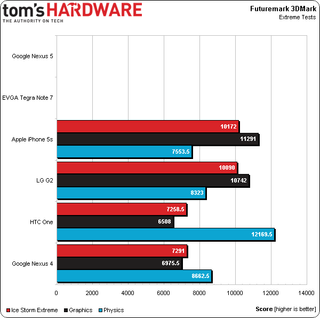
Now this is more like it. It's a test that Adreno 330 and the GeForce ULP inside the Tegra 4 consistently max out. Apple's PowerVR-based graphics engine should be doing better, but surprisingly, it seems to be held back by the A7's CPU core, and only specifically in this test.
With that said, why is the LG G2 not maxing out this test as well? It uses the same Snapdragon 800 as the Nexus 5, so what's holding it back? Android 4.2.2? A slower GPU core than it should have? Perhaps we need to think of hitting this test's ceiling relatively. If maxed out means anything over 11,000 points, the LG G2 and Apple iPhone 5s really only fall slightly below that line.

Again, our Nexus 5 takes the lead, beating the Tegra 4 on everything but Physics. The G2 is up with the big dogs as well.
Interestingly, Apple's iPhone 5s is slow here too. Futuremark went to some lengths to explain why, but essentially the A7 CPU Core in the iPhone 5s doesn’t seem to handle the Bullet Physics Library and its use of “complex data structures” well.
Stay on the Cutting Edge
Join the experts who read Tom's Hardware for the inside track on enthusiast PC tech news — and have for over 25 years. We'll send breaking news and in-depth reviews of CPUs, GPUs, AI, maker hardware and more straight to your inbox.
Basemark GUI
Rightware is another benchmarking stalwart with a well known toolset, and Basemark GUI is the company’s Android UI performance test. It’s designed to simulate the demands of intensive UI use in 3D (think applications like Google Maps). As with 3DMark, though, it is starting to be overshadowed by more modern SoCs and implementations of Android (since version 4.1, more and more of Android’s UI is rendered in hardware).
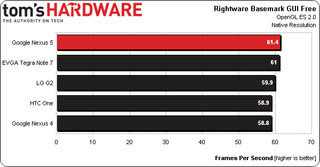
At native resolution, each device seems to perform as it should, though it does seem a little strange that the Nexus 4 can't seem to beat the others given its lower screen size, with far fewer pixels for its GPU to push.
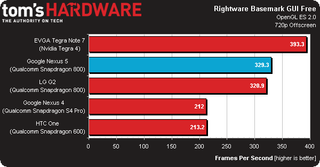
Okay, now we're seeing a shake-up. Nvidia's Tegra Note flattens the competition (as it should given its form factor) and our Nexus 5 finishes in second place, only marginally ahead of the LG G2. HTC One should not be that slow in terms of hardware, so clearly it's just the native Android 4.4 (and in particular Project Svelte) of the Nexus 4 which is making the HTC look poor.
Basemark X
Basemark X is a multi-platform benchmark based on a real game engine, Unity 4.0. It uses many of Unity’s modern features via the OpenGL ES 2.0 render path, just as a modern game would. Features like high poly count models, shaders with normal maps, complex LoD algorithms, extensive per-pixel lighting (including directional and point light), along with a comprehensive set of post process, particle systems, and physics effects test how a modern game might look and run. It’s an aggressive test that still hasn’t been maxed out by the latest mobile SoCs.
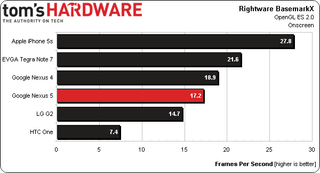
Yes folks, this is a tough test indeed. The A7's Rogue-based GPU comfortably leads, but it’s still below 30 FPS, even with its substantially lower target resolution.
The Nexus 4's advantage comes from its smaller screen size in this native resolution benchmark. LG's G2 should be right up there with it, so this is no doubt due to the difference between the Nexus 5's Android 4.4.2 working in its favor.
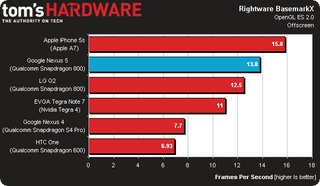
Now we're getting somewhere. When the playing field (resolution) is level, Apple's Rogue-based GPU can't just walk away with the crown. Our Nexus 5 puts in a strong showing with the equivalent LG G2 not that far behind.
It's disappointing that the two 720p-level devices perform so poorly, but HTC's One gets the worst of it. We’re pretty sure that the Sense UI isn’t doing it any favors here.
Current page: Results: GPU Benchmarks
Prev Page Results: CPU Benchmarks Next Page Results: GPU Benchmarks, Continued-
guvnaguy Nice review. I think the whole $600-700 price for an off-contract phone is pretty much theft anyway, when the phones cost <$300 to make. Kudos, Google.Reply -
MoulaZX The Nexus 5 is extremely susceptible to thermal throttling which this article seems to gloss over or entirely miss.Reply
Yes PVS scores do indicate something. They indicate the efficiency of a chip at a given frequency. The lower PVS numbers will heat up faster, and thus be at the optimal 2.23Ghz frequency less often, thus giving the perceived impression of being significantly slower.
I have a Nexus 5 myself, same PVS scoring (1). Running Antutu in my hand, and I'll score 22,000 - 23,000. However, out of curiosity, I rest the phone on an AC vent for 15 minutes, started the Antutu benchmark while leaving it there, and managed to score 29,500. All results easily and consistently repeatable. And my phone has never been unlocked/flashed. 100% Factory ROM, 4.4.2.
The issue purely heavy thermal throttling under heavy sustained loads.
In day to day operations though, it is absolutely flawless, and felt ever so slightly snappier then my previous HTC One (M7). Still incredibly happy with this device, and the only one I have never felt the need to unlock and flash silly. My only gripe was Camera issues, but the 4.4.2 update resolved those problems. -
beetlejuicegr So a friend bought Nexus 5 and i bought his nexus 4 for me. Really happy with it even if its a last year's mobile. Economy crisis in Greece just won't give me space to buy Nexus 5 :P. Nexus phones are always on the the top list in quality and especially on price/quality mark. It is just that the way google sells them in Europe that is incompatible with the mentality of mobile buyers here. I bet my right thumb :P that if they had few actual shops inside shopping centers in Europe that they would sell like crazy. Now that i think about it, they know it, they just let other mobile companies for this, for android dominance perhaps? Just like what IBM did with PC and DoS? All were awed to see my Nexus One just when it was released few years ago, which i still have and still works fine, i doubt if an iphone or any 600+ $/euro mobile can survive that long right?Reply -
beetlejuicegr Oh and to add, this heating throttling might be annoying if it is used on a warm country like Greece i guess? Can the article elaborate on that? (room temperatures vs performance)Reply -
davidjan Great phone. N4 doesn't support OTG. But N5 supports. So can use Meenova MicroSD reader to add its storage: http://goo.gl/2iJ6gfReply -
clownbaby I finally pulled the trigger on a Nexus 5 and am upgrading my trusty old GNex. The unpolluted android system is by far the most underrated aspect of the Nexus devices. Paired with a crazy enthusiastic development community, Google offers a device experience that can't be had for any price by other manufacturers. To all of this, top end quick hardware is just icing on the cake. I would take a Nexus device with half the performance of an Iphone or Galaxy 4 just for the software environment.Reply -
yasamoka The LG G2 does not have a microSD slot. Only the Note 3 does out of the 3 handsets mentioned in the article.Reply
Most Popular

